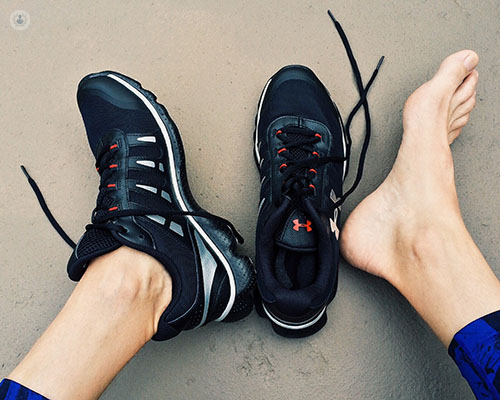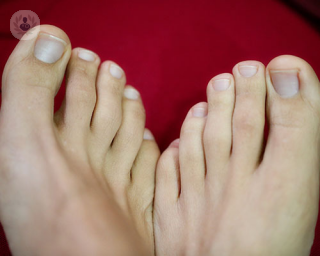Hammer toe
Mr Shafic Al-Nammari - Orthopaedic surgery
Created on: 07-06-2018
Updated on: 05-09-2023
Edited by: Conor Dunworth
What is hammer toe?
Each toe has three joints - except for the first (big) toe, which usually has only two joints.
In hammer toe, the affected toe is bent at the middle joint, which is called the proximal interphalangeal (PIP) joint.
There are stages of hammer toe:
- Rigid hammer toe – This is when the deformity is rigid and cannot be pulled back straight. This type of hammer toe is more likely to require surgery.
- Flexible hammer toe – this is a milder form of the condition. You can still straighten the toes by gentling pulling on them.

What are the symptoms of hammer toe?
In addition to the visible deformity of the toe, common symptoms are:
- Pain - both deep seated pain in the toe and pain from rubbing are common.
- Swelling or redness.
- Inability to straighten the toe.
- A corn or callus on top of the middle joint of the toe or on the tip of the toe.
How is hammer toe diagnosed?
A physical examination by a doctor will usually be able to confirm a diagnosis of hammer toe. You may also have an X-ray if bone or tendon damage is suspected. The X-ray can also show the severity of the hammer toe and be helpful for surgical planning.

What are the causes of hammer toe?
Hammer toes usually appear as a result of muscle imbalance to the toe.
Muscles act across the toe joints and tend to work in synchrony to bend and straighten the toes. If they become imbalanced and the toe is held in a flexed (bent) position for long enough, the muscles and the joint structures themselves tighten further and can no longer stretch out.
In addition, several other factors can cause hammer toes including:
- Arthritis
- A high foot arch
- Poorly fitting shoes
- Bunions can put pressure on adjacent toes
- Injury (e.g., a stub or break in the toe)
- An abnormal balance of muscles and tendons in the toe
- Nerve damage
Can hammer toe be prevented?
The following measures reduce the risk of hammer toe forming:
- Wear well-fitted shoes. Flat shoes with a wide toe box are best. Shoes that are too small, high heels and narrow pointed toe boxes are more likely to cause hammer toes.
- Treat bunions before they cause a hammer toe.

How is hammer toe treated?
Treatment will depend on the severity and symptoms of the hammer toe.
Milder cases can be treated at home, using a combination of comfortable shoes, shoe cushions or pads and treatments for any bunions or corns. Gently stretching the toes can help to relieve pain and discomfort.
More severe and painful cases of hammer toe where the same treatments noted above are not helping are more likely to require surgery. There are a number of different types of surgery available:
- Basal phalangectomy – the base of the bone beneath the hammer toe is removed in this procedure.
- Tendon transfer – in this procedure the tendons from underneath the toe are attached to the top of the toe. This has the effect of straightening out the hammer toe.
- Arthrodesis – this procedure involves pinning the joint straight permanently.
- Arthroplasty – this involves the removal of part of the joint involved in the hammer toe, which allows the toe to lie flat.
- Weil osteotomy –this procedure resets and shortens the metatarsal bones in your foot, which allows the toes to straighten out.
Surgery is usually done as a day case. It can be under general anaesthetic or local anaesthetic.
What is the recovery period like after hammer toe surgery?
After hammer toe surgery, you should try to keep the foot elevated to help control pain and swelling. There will be a bandage over the toesand you will be provided with a special shoe to allow you to walk.

Which type of specialist treats hammer toe?
Orthopaedic surgeons treat hammer toes.








